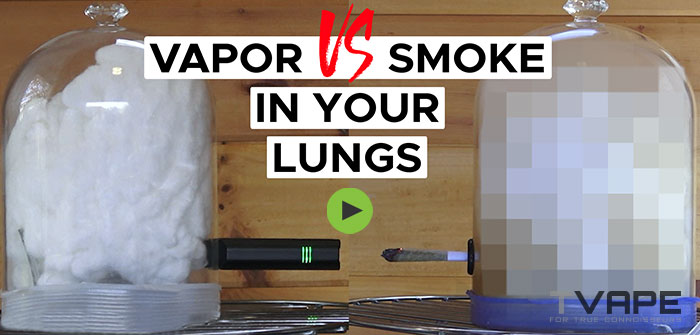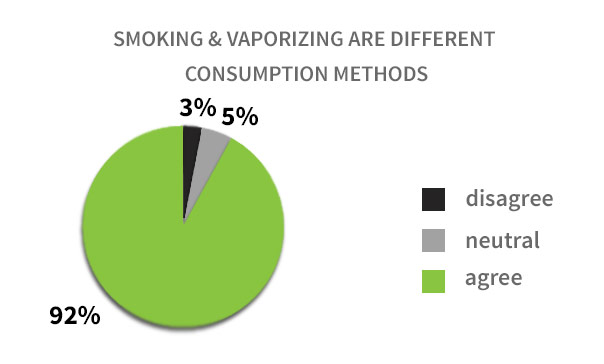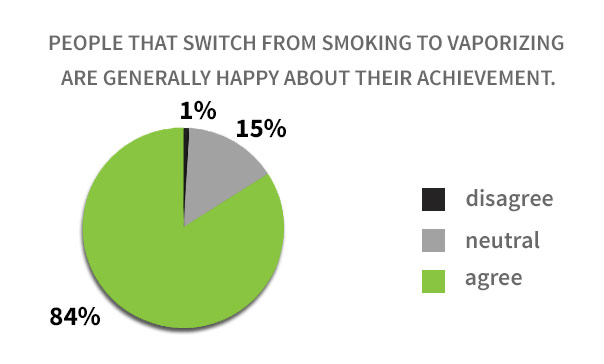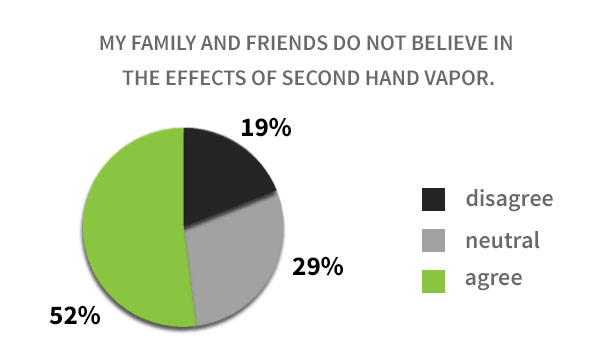Smoking vs Vaporizing: Consumer Survey Report
by: Clemens Tscheka
Chief Research Officer
We reached out to 5000 vaporizer users to participate in an anonymous survey and received at the time of writing approximately 700 responses to determine the consumer perception of vaporizing vs smoking. We know vaporizers can help save you money but we wanted to dig a bit deeper on how people perceived they impacted their health, on top of impacting their wallet.
There are several studies, like one conducted in 2007 by the Harm Reduction Journal, that try to determine the overall health impact of both consumption methods, but our main interest with this survey is to gain an insight into how vaporizer users and their friends and family perceive the two different consumption methods.
On our part, we also conducted our own visual experiment on the effects of vapor vs smoke. While we’re not making any claims that this video serves as conclusive proof that vaporizing dry herb is 100% safe, we’re hoping that it provides a visual guide of the effects of smoking vs vaporizing inside our lungs.

Our hypothesis is that people generally perceive vaporizing as a less impactful consumption method opposed to smoking, are happier that they have made the switch and that people would like to see the health insurance companies and laws to treat the two methods differently. Customers were given Likert Scale statements in which we asked them to rate each statement on a scale of 1 to 10, 1 being strongly disagree and 10 being strongly agree.
For the purpose of keeping the data simple we determined rankings 1 – 4 would be considered disagree, 5 – 6 is neutral and 7 – 10 is agree. The results can be found below:
Is vaping smoking?
 When consumers are asked if they consider using their vaporizer as smoking 67% percent disagreed with this statement and only 19% agreed. The general perception appears to be that people who use vaporizers fundamentally feel that there is a difference between the two intake methods and do not consider them one in the same.
When consumers are asked if they consider using their vaporizer as smoking 67% percent disagreed with this statement and only 19% agreed. The general perception appears to be that people who use vaporizers fundamentally feel that there is a difference between the two intake methods and do not consider them one in the same.
When given the statement in a more straight forward matter, declaring smoking and vaporizing different methods of consumption 92% of surveyers believe that these two methods are inherently different. It is interesting that there is such a large difference between this reply and the former. Perhaps it is just a case of wording and that some of those who use vaporizers still refer to the exhaled vapor as smoke and thus feel that vaporizing and smoking are similar in concept.
Perceptions about health and wellness.
The Canadian Journal of Respiratory Therapy produced a study that suggests vaporizing is less impactful to the respiratory system. Another study by the International Journal of Drug policy experienced similar results in their trial. We wanted to see if our customers feel similarly when making the switch and if they are generally happier with their decision.

86% of those surveyed said that they felt generally better after vaporizing as opposed to smoking and 92% of those surveyed said that they felt the switch has benefitted their health overall. You can learn more about the benefits to making the switch here.
From these 2 results we can gather that those who have switched to vaporizing seem to feel generally better after this form of consumption and believe it has benefitted their health as oppose to smoking. This perception seems to be in line with most studies that share a similar conclusion, including a similar survey produced by the Substance Abuse Journal in 2013.
We also asked users if they were happy with their decision to switch from smoking to vaporizing. 85% of respondents were happy that they made the switch while only 1% replied that they were not happy. Overall users who switch seem to be content with their achievement and its perceived impact on their life.
What about vaporizing indoors?
This topic has drawn the ire of politicians and the public alike. In an article by the Globe and Mail, Allison Jones writes about Ontario’s recent ban of vaporizing indoors and how public perception has driven this decision. Even though people who use vaporizers believe the consumption methods are different the general public still largely perceives smoking and vaporizing as one in the same. This forces politicians to make sweeping generalizations when passing laws to pacify fears of the public. Most of these fears are centralized around exposure to second hand vapor and its effects, if any at all.
59% of people who replied stated that friends and family allow them to vaporize indoors as compared to smoking. This result suggests that people who are close to those who have made the switch understand the difference in methods of consumption and generally feel safer allowing their loved ones to vaporize indoors than smoking.
When asked about whether their family members believed in the effects of second hand vapor, 52% replied that their friends and family did not believe in it, while 29% were on the fence and only 19% perceived that the effects of second hand vapor are real. When it comes to vaporizing the general perception from family members who have experience with those who vaporize is that they have experienced no effects of second hand vapor.
We then asked about the impact of vaporizing on the indoor environment, 80% believed there is no lingering effects of vaporizing indoors as opposed to smoking. Only 10% perceived any lingering effects of vaporizing indoors which leads us to draw the conclusion that in general consumers feel there is little to no lasting impact on the indoor environment when vaporizing. Keep in mind these are individuals that vaporize on a regular basis and arguably well experienced in assessing effects of vaporizing indoors as compared to the general public. A study conducted by airfilters.com came to a similar conclusion when comparing vaporizers to other methods of smoking and the impact of odor on the indoor environment.
Despite the perception of the general public, vaporizer users and their friends and family commonly recognize vaporizing indoors as less impactful on the people around them and their environment and is viewed as more acceptable than smoking.
Need for Policy Reform?
In light of the above results, people who have experience with vaporizers believe that not only are smoking and vaporizing fundamentally different but also perceive that the overall effects on their living situation and others is negligible. If they truly feel this is the case we posed to vaporizer users whether or not certain policies should be addressed to be more accepting of vaporizer users.
When probed about whether or not health insurance companies should view those who only vaporize different in their policy vs those who smoke, 78% believed they should be treated differently than smokers. Only 11% believed that smokers and vapers should be treated one and the same when it comes to health insurance with another 11% remaining neutral. The general perception from users is that they are not smokers and have taken steps to improve their quality of life which should be reflected on their insurance. We have internal reports from the sales department that customers have forwarded their invoices to places like ODSP, WSIB, Veterans Affairs and Private Insurance Companies for coverage. Please note that these are verbal reports from customers during a sales call.
Isabel Teotonio of the Toronto Star wrote an article about a patient who had his medicine and vaporizer covered by their private insurance company. We should note that this is not a standard practice and is handled on a case by case basis, the article highlights that both SunLife and Manulife “consider requests for exceptions if directed by the organization or employer responsible for the benefit plan”.
When we proposed a similar statement but addressing how the law should treat vaporizing vs smoking, 69% believed that the law should treat vaporizing differently than smoking. As we previously touched upon, the general public perception feels the opposite and therefore the law makers currently have lumped the two together. Unfortunately without awareness and education of the public it is difficult to shift public perception. In the vaporizing community it is strongly felt that the two methods are different and should be treated as such. Hopefully with some time and education public perception will shift to meet the current beliefs held by vaporizer users and their friends.
What is interesting when comparing results between health insurance reform and law reform is that almost 10% less respondents felt laws should accommodate vapers vs health insurance. One would think that there would be a closer relation between these two answers, but perhaps people see the stricter regulation by the government as a necessity to maintain the status quo and out of general respect for non-users. Whatever the reason it is a difference worth noting as people’s perceptions tend to differ between what the Law should dictate and what Health Insurance should cover.
Final Thoughts
From our survey we can determine that vaporizer users believe that vaporizing and smoking are profoundly different methods of consumption. When compared to smoking vaporizer users generally feel better after vaporizing, feel that it has benefited their health in the long run and are happy with their achievement in making the switch. Friends and family of vaporizer users seem to perceive vaporizing indoors as more acceptable than smoking and users believe there is very little impact on the living environment. Friends and family of vaporizer users also believed the effects of 2nd hand vapor to be virtually non-existent and no cause for alarm like the general public perceives. With all of this in mind vaporizer users feel that both the law and health insurance providers should treat those who vaporizer differently from those who smoke. The main limitation to this study is that our data comes straight from vaporizer consumers, however our aim was to survey the opinion of people with experience with vaporizers to form a consensus of their perception towards their usage. With the line of questioning we did not feel comfortable approaching non-vaporizer users who had no first hand experience with these devices.
As vaporizer culture pushes its way into the mainstream we can expect to see changing opinions and perceptions towards the use of these devices. We hope that this study and future studies help inform the general public and shed light on certain perceptions and perhaps misunderstanding towards vaporizers and their users. If you currently use a vaporizer or if you have never used one in your life, we would love for you to weigh in and share your thoughts on this topic.














